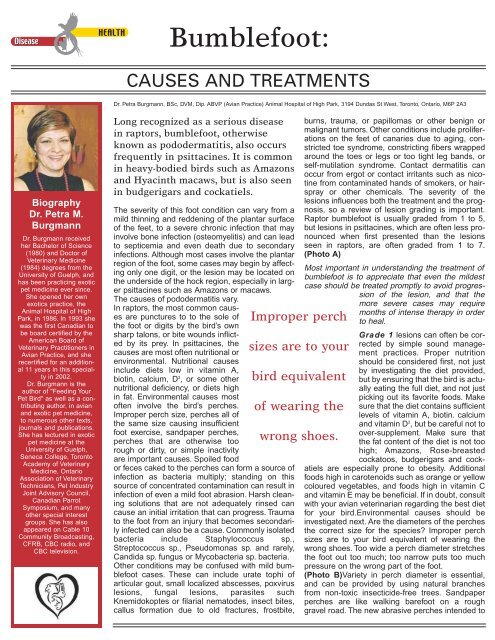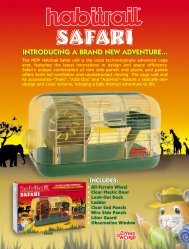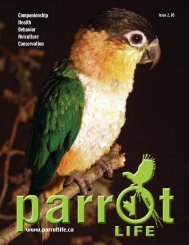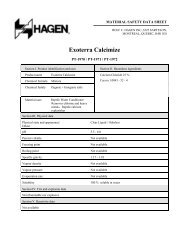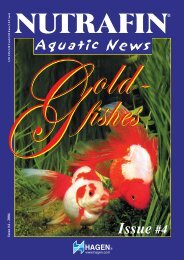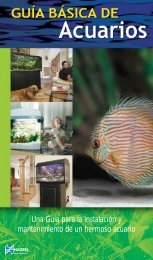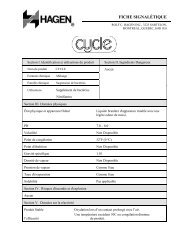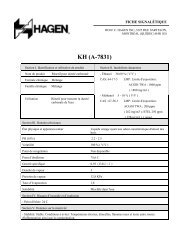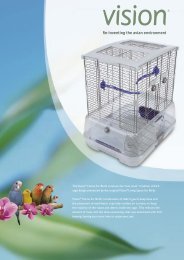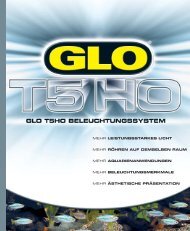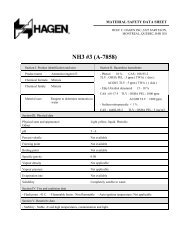parrotLife_Printers-3 (Page 1) - Rolf C. Hagen Inc.
parrotLife_Printers-3 (Page 1) - Rolf C. Hagen Inc.
parrotLife_Printers-3 (Page 1) - Rolf C. Hagen Inc.
Create successful ePaper yourself
Turn your PDF publications into a flip-book with our unique Google optimized e-Paper software.
Disease Disease<br />
Biography<br />
Dr. Petra M.<br />
Burgmann<br />
Dr. Burgmann received<br />
her Bachelor of Science<br />
(1980) and Doctor of<br />
Veterinary Medicine<br />
(1984) degrees from the<br />
University of Guelph, and<br />
has been practicing exotic<br />
pet medicine ever since.<br />
She opened her own<br />
exotics practice, the<br />
Animal Hospital of High<br />
Park, in 1986. In 1993 she<br />
was the first Canadian to<br />
be board certified by the<br />
American Board of<br />
Veterinary Practitioners in<br />
Avian Practice, and she<br />
recertified for an additional<br />
11 years in this specialty<br />
in 2002.<br />
Dr. Burgmann is the<br />
author of "Feeding Your<br />
Pet Bird" as well as a contributing<br />
author, in avian<br />
and exotic pet medicine,<br />
to numerous other texts,<br />
journals and publications.<br />
She has lectured in exotic<br />
pet medicine at the<br />
University of Guelph,<br />
Seneca College, Toronto<br />
Academy of Veterinary<br />
Medicine, Ontario<br />
Association of Veterinary<br />
Technicians, Pet Industry<br />
Joint Advisory Council,<br />
Canadian Parrot<br />
Symposium, and many<br />
other special interest<br />
groups. She has also<br />
appeared on Cable 10<br />
Community Broadcasting,<br />
CFRB, CBC radio, and<br />
CBC television.<br />
HEALTH<br />
Bumblefoot:<br />
CAUSES AND TREATMENTS<br />
Dr. Petra Burgmann, BSc, DVM, Dip. ABVP (Avian Practice) Animal Hospital of High Park, 3194 Dundas St West, Toronto, Ontario, M6P 2A3<br />
Long recognized as a serious disease<br />
in raptors, bumblefoot, otherwise<br />
known as pododermatitis, also occurs<br />
frequently in psittacines. It is common<br />
in heavy-bodied birds such as Amazons<br />
and Hyacinth macaws, but is also seen<br />
in budgerigars and cockatiels.<br />
The severity of this foot condition can vary from a<br />
mild thinning and reddening of the plantar surface<br />
of the feet, to a severe chronic infection that may<br />
involve bone infection (osteomyelitis) and can lead<br />
to septicemia and even death due to secondary<br />
infections. Although most cases involve the plantar<br />
region of the foot, some cases may begin by affecting<br />
only one digit, or the lesion may be located on<br />
the underside of the hock region, especially in larger<br />
psittacines such as Amazons or macaws.<br />
The causes of pododermatitis vary.<br />
In raptors, the most common causes<br />
are punctures to to the sole of<br />
the foot or digits by the bird’s own<br />
sharp talons, or bite wounds inflicted<br />
by its prey. In psittacines, the<br />
causes are most often nutritional or<br />
environmental. Nutritional causes<br />
include diets low in vitamin A,<br />
biotin, calcium, D3 , or some other<br />
nutritional deficiency, or diets high<br />
in fat. Environmental causes most<br />
often involve the bird’s perches.<br />
Improper perch size, perches all of<br />
the same size causing insufficient<br />
foot exercise, sandpaper perches,<br />
perches that are otherwise too<br />
rough or dirty, or simple inactivity<br />
are important causes. Spoiled food<br />
or feces caked to the perches can form a source of<br />
infection as bacteria multiply; standing on this<br />
source of concentrated contamination can result in<br />
infection of even a mild foot abrasion. Harsh cleaning<br />
solutions that are not adequately rinsed can<br />
cause an initial irritation that can progress. Trauma<br />
to the foot from an injury that becomes secondarily<br />
infected can also be a cause. Commonly isolated<br />
bacteria include Staphylococcus sp.,<br />
Streptococcus sp., Pseudomonas sp. and rarely,<br />
Candida sp. fungus or Mycobacteria sp. bacteria.<br />
Other conditions may be confused with mild bumblefoot<br />
cases. These can include urate tophi of<br />
articular gout, small localized abscesses, poxvirus<br />
lesions, fungal lesions, parasites such<br />
Knemidokoptes or filarial nematodes, insect bites,<br />
callus formation due to old fractures, frostbite,<br />
Improper perch<br />
sizes are to your<br />
bird equivalent<br />
of wearing the<br />
wrong shoes.<br />
burns, trauma, or papillomas or other benign or<br />
malignant tumors. Other conditions include proliferations<br />
on the feet of canaries due to aging, constricted<br />
toe syndrome, constricting fibers wrapped<br />
around the toes or legs or too tight leg bands, or<br />
self-mutilation syndrome. Contact dermatitis can<br />
occur from ergot or contact irritants such as nicotine<br />
from contaminated hands of smokers, or hairspray<br />
or other chemicals. The severity of the<br />
lesions influences both the treatment and the prognosis,<br />
so a review of lesion grading is important.<br />
Raptor bumblefoot is usually graded from 1 to 5,<br />
but lesions in psittacines, which are often less pronounced<br />
when first presented than the lesions<br />
seen in raptors, are often graded from 1 to 7.<br />
(Photo A)<br />
Most important in understanding the treatment of<br />
bumblefoot is to appreciate that even the mildest<br />
case should be treated promptly to avoid progression<br />
of the lesion, and that the<br />
more severe cases may require<br />
months of intense therapy in order<br />
to heal.<br />
Grade 1 lesions can often be corrected<br />
by simple sound management<br />
practices. Proper nutrition<br />
should be considered first, not just<br />
by investigating the diet provided,<br />
but by ensuring that the bird is actually<br />
eating the full diet, and not just<br />
picking out its favorite foods. Make<br />
sure that the diet contains sufficient<br />
levels of vitamin A, biotin. calcium<br />
and vitamin D 3 , but be careful not to<br />
over-supplement. Make sure that<br />
the fat content of the diet is not too<br />
high; Amazons, Rose-breasted<br />
cockatoos, budgerigars and cockatiels<br />
are especially prone to obesity. Additional<br />
foods high in carotenoids such as orange or yellow<br />
coloured vegetables, and foods high in vitamin C<br />
and vitamin E may be beneficial. If in doubt, consult<br />
with your avian veterinarian regarding the best diet<br />
for your bird.Environmental causes should be<br />
investigated next. Are the diameters of the perches<br />
the correct size for the species? Improper perch<br />
sizes are to your bird equivalent of wearing the<br />
wrong shoes. Too wide a perch diameter stretches<br />
the foot out too much; too narrow puts too much<br />
pressure on the wrong part of the foot.<br />
(Photo B)Variety in perch diameter is essential,<br />
and can be provided by using natural branches<br />
from non-toxic insecticide-free trees. Sandpaper<br />
perches are like walking barefoot on a rough<br />
gravel road. The new abrasive perches intended to


